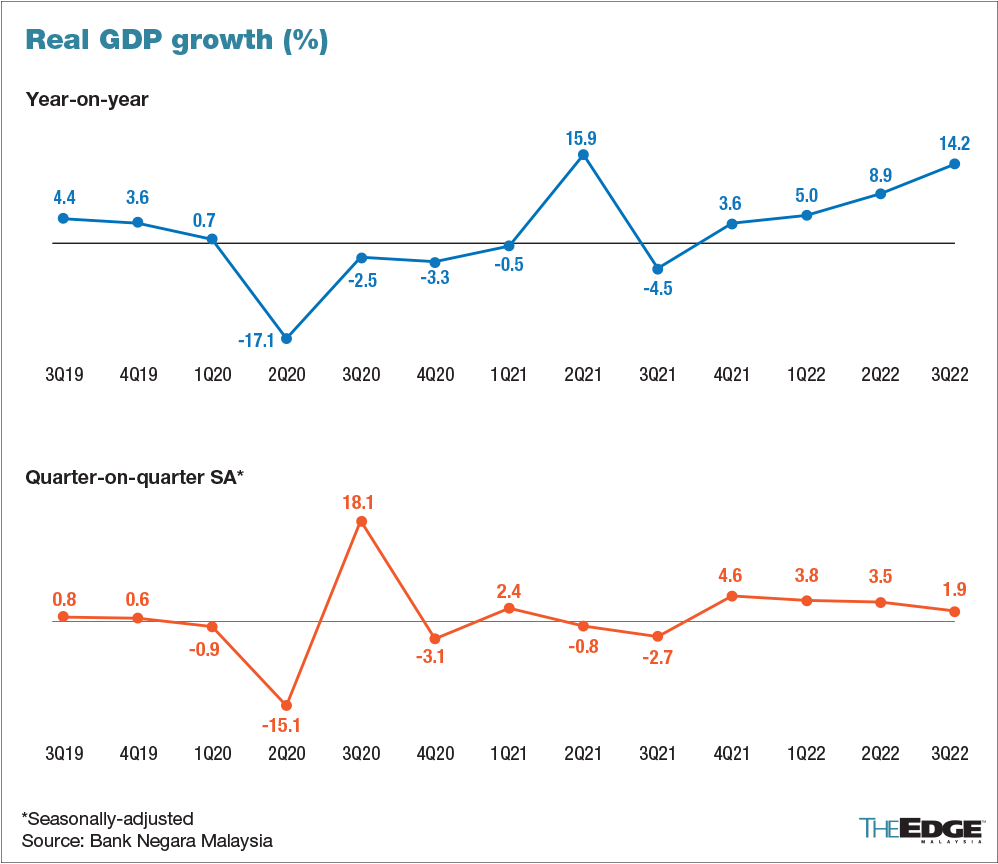
Bank Negara Malaysia governor Tan Sri Nor Shamsiah Mohd Yunus says headline inflation is likely to have peaked for the year at 4.5% during the third quarter of 2022, while core inflation increased further to 3.7% from 2.5% in the second quarter. (Photo by Mohamad Shahril Basri/The Edge)
KUALA LUMPUR (Nov 11): Malaysia’s economy, as measured by gross domestic product (GDP), grew by 14.2% year-on-year (y-o-y) in the third quarter of 2022 (3Q2022) on the back of continued expansion of domestic demand, a firm recovery in the labour market and income condition amid normalising economic activity, as well as ongoing policy support, Bank Negara Malaysia (BNM) said on Friday (Nov 11).
The last time GDP growth exceeded 10% was in 2Q2021, where it expanded by 16.1%.
In a statement, the central bank said exports remained supported by strong demand for electric and electronics products.
Meanwhile, the recovery in inbound tourism lent further support to economic activity.
By sector, the services and manufacturing sectors continued to drive growth.
Quarter-on-quarter (q-o-q), the economy grew by 1.9%. In comparison, GDP grew by 3.5% q-o-q in 2Q2022.
Overall, the Malaysian economy expanded by 9.3% in the first three quarters of 2022.
Headline inflation likely to have peaked at 4.5% this year
BNM governor Tan Sri Nor Shamsiah Mohd Yunus said headline inflation is likely to have peaked for the year at 4.5% during the quarter, while core inflation increased further to 3.7% from 2.5% in 2Q2022.
“As expected, the increase in headline inflation was largely driven by the base effect from the discount on electricity bills implemented in 3Q2021, as well as sustained increases in core inflation and price-volatile items.
“The inflationary pressures reflected the confluence of elevated cost pressures, particularly for food-related items, and strong demand conditions,” the governor said.
For 2023, the governor said headline and core inflation are expected to remain elevated amid both demand and cost pressures, as well as any changes to domestic policy measures.
On the ringgit, she reiterated that the local currency had weakened mainly on the back of a stronger-than-ever US dollar.
“The central bank will continue to closely monitor market developments, and ensure that adjustments remain orderly to support effective intermediation for the economy,” the governor said.
The ringgit depreciated by 4.9% against the US dollar in 3Q2022, in line with regional currencies which depreciated by an average of 5.5%.
“This reflected continued strengthening of the US dollar amid further monetary policy tightening by the US Federal Reserve, and higher investor risk aversion due to moderating global growth prospects,” she added.
GDP growth seen at 4% to 5% next year
Moving forward, Nor Shamsiah added that although domestic financial markets may face the risk of higher volatility, spillovers to domestic financial intermediation are expected to remain contained, supported by Malaysia’s healthy external position and well-capitalised banking system.
The central bank foresees a GDP growth of 4% to 5% next year amid a challenging global growth outlook, she said.
- AMMB CFO to step down, said to be joining Maybank
- PNB looking to quit legacy investments to strengthen portfolio
- China raises tariffs on US goods to 84% as trade rift worsens
- Questions arise as to how front passenger door to Yusoff Rawther's car could be opened
- Axiata said to seek adviser for Edotco sale — Bloomberg
- Trump pauses higher duties on most nations, hikes China tariffs to 125%
- Asean emerges as a central player in global economy after overcoming series of adversities — Anwar
- Spain pushing for EU pivot to China to counter Trump tariffs
- Spain defends closer trade ties with China after US warns against 'cutting own throat'
- US weighs farmer bailout as China retaliation threatens exports

